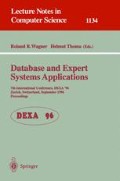Abstract
VIENA Classroom is a distance education system in which the teaching material is prepared as hypermedia documents and presented to the students within a CSCW environment. By applying language engineering techniques to the question support facilities of the system we create a multimodal natural language interface so that the students can formulate their questions directly in Japanese. Based on the computed semantic representations the questions are either answered by accessing a FAQ knowledge base or collected and transferred to the teacher for later processing. As valuable assistance for formulating questions we provide the possibility to browse through automatically generated FAQ lists. Language engineering is performed in an integrated framework by utilizing deductive object-oriented database technology.
Preview
Unable to display preview. Download preview PDF.
References
Androutsopoulos, I., Ritchie, G.D., Thanisch, P.: Natural Language Interfaces to Databases — an Introduction. Journal of Natural Language Engineering (1994)
Barja, M.L. et al.: An Effective Deductive Object-Oriented Database Through Language Integration. Proc. of the Intl. Conf. on Very Large Data Bases (1994)
Binot, J.-L. et al.: Natural Language Interfaces: A New Philosophy. Sun Expert Magazine (1991)
Cowie, J., Lehnert, W.: Information Extraction. Communications of the ACM, Vol. 39, No. 1 (1996)
Cunningham, H., Gaizauskas, R.J., Wilks, Y.: A General Architecture for Language Engineering (GATE) — a New Approach to Language Engineering R&D. Techn. Rep. CS-95-21, Department of Computer Science, University of Sheffield (1996)
Ellis, C.A., Gibbs, S.J., Rein, G.I.: Groupware: Some Issues and Experiences. Communications of the ACM, Vol. 34, No. 1 (1991)
Fujii, H., Croft, W.B.: A Comparison of Indexing Techniques for Japanese Text Retrieval. Proc. of the Annual Intl. ACM SIGIR Conf. (1993)
Hiyoshi, M., Shimazu, H.: Drawing Pictures with Natural Language and Direct Manipulation. Proc. of the Intl. Conf. on Computational Linguistics (1994)
Kagawa, O. et al.: Capturing Essential Questions Using Question Support Facilities in the VIEW Classroom. Proc. of the Intl. Conf. on Database and Expert Systems Applications (1995)
King, M.: Evaluating Natural Language Processing Systems. Communications of the ACM, Vol. 39, No. 1 (1996)
Lewis, D.D., Sparck Jones, K.: Natural Language Processing for Information Retrieval. Communications of the ACM, Vol. 39, No. 1 (1996)
Marsh, E., Wauchope, K., Gurney, J.: Human-Machine Dialogue for Multi-Modal Decision Support Systems. Proc. of the AAAI Spring Symp. on Multi-Media Multi-Modal Systems (1994)
McClain, Y.M.: Handbook of Modern Japanese Grammar. Hokuseido Press, Tokyo (1981)
McFetridge, P., Groeneboer, C.: Novel Terms and Coordination in a Natural Language Interface. Rhamani, S., Chandrasekar, R., Anjaneyulu, K.S.R. (eds): Knowledge Based Computer Systems. Springer, Berlin (1990)
Winiwarter, W.: The Integrated Deductive Approach to Natural Language Interfaces. Diss., University of Vienna (1994)
Winiwarter, W.: MIDAS — the Morphological Component of the IDA System for Efficient Natural Language Interface Design. Proc. of the Intl. Conf. on Database and Expert Systems Applications (1995)
Winiwarter, W.: Unknown Value Lists and Their Use for Semantic Analysis in IDA — the Integrated Deductive Approach to Natural Language Interface Design. Proc. of the Australasian Database Conf. (1996)
Winiwarter, W., Kagawa, O., Kambayashi, Y.: Multimodal Natural Language Interfaces for Hypermedia Distance Education — the VIENA Classroom System. Proc. of the Intl. Congress on Terminology and Knowledge Engineering (1996)
Winiwarter, W., Kagawa, O., Kambayashi, Y.: Syntactic Disambiguation by Using Categorial Parsing in a DOOD Framework. Proc. of the German Annual Conf. on Artificial Intelligence (to appear)
Author information
Authors and Affiliations
Editor information
Rights and permissions
Copyright information
© 1996 Springer-Verlag Berlin Heidelberg
About this paper
Cite this paper
Winiwarter, W., Kagawa, O., Kambayashi, Y. (1996). Applying language engineering techniques to the question support facilities in VIENA classroom. In: Wagner, R.R., Thoma, H. (eds) Database and Expert Systems Applications. DEXA 1996. Lecture Notes in Computer Science, vol 1134. Springer, Berlin, Heidelberg. https://doi.org/10.1007/BFb0034715
Download citation
DOI: https://doi.org/10.1007/BFb0034715
Published:
Publisher Name: Springer, Berlin, Heidelberg
Print ISBN: 978-3-540-61656-6
Online ISBN: 978-3-540-70651-9
eBook Packages: Springer Book Archive

